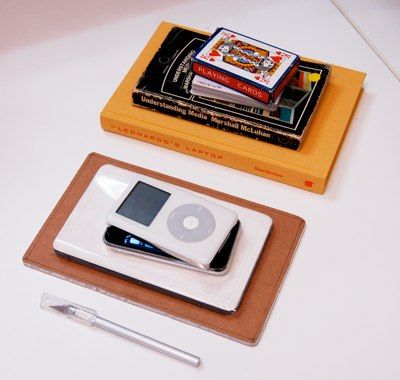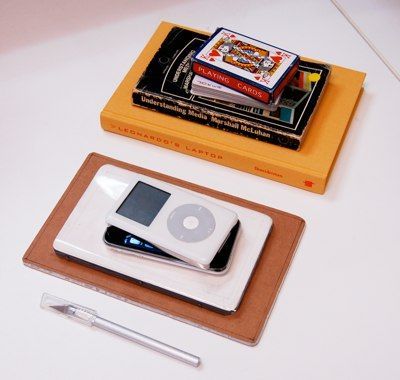Form factors
[From September 2009, four months before the iPad launch] – I’ve been obsessed lately with form factors for interactive devices. To the extent that I’ve been carrying around models of tablet computers made of foam core and acetate, just to get the feel...

[I wrote this in September 2009, four months before the 27 January 2010 announcement of the iPad. On 26 January 2010, the day before the launch, I wrote a followup post: imaginary tablets.]
I’ve been obsessed lately with form factors for interactive devices. To the extent that I’ve been carrying around models of tablet computers made of foam core and acetate, just to get a feel for how they might fit into life. It might be considered a little silly to carry around blocks of shiny foam that don’t do anything, but that hasnt stopped me. After all @timjmansfield tells me that I’m conducting a phenomenological investigation, so it must be alright.

So why these sizes?
Because they’re natural sizes, products of cultural evolution that are worth paying attention to.
The model for this idea is the iPod (and by extension the iPhone) – the Deck of Cards form factor (a 3.5 inch screen). Below that on the stack is what I call the Penguin Classic, or the Paperback form factor (which corresponds to a 7 inch screen). Finally we have the Hardback (a 10 inch screen).
You see – a deck of cards could take any form, but it took this one. We humans settled on that shape and size; even the details like rounded corners. So let’s extend the thought: what other forms have evolved? People love the Penguin paperback form factor. Small enough for a coat pocket or a purse, large enough to be legible. A hardback makes a different tradeoff; a bit more room for text and illustrations, and a bit less portability. We choose these forms.
Laptops as we know them have a different tradeoff; they are constrained by the keyboard. Text entry has been a primary mode of interaction since the command line, and any proper computer is supposed to have a proper keyboard. I’m typing this on a 15 inch MacBook Pro, which is all very nice. I can work in any room of my house, and bring a full-scale computer wherever I need one. But whenever possible I don’t take it with me. It won’t fit in a normal bag, only specialised laptop bags with padded compartments that leave little room for anything else. It’s too heavy to carry on my back on a long bike ride and too fragile for the panniers. This is tricky because I work digitally, online, in many different places. My iPhone has made it possible to leave the laptop behind far more often. The tiny screen is worth it for the portability.
But I’d be happier with a form factor that was somewhat less portable. The paperback in particular is ideal for mobile use. It’s easy to bring everywhere, almost unnoticed in the small bag I was taking anyway, or in a coat pocket. High resolution (for example a Pixel Qi transreflective – colour with the backlight on and high-res monochrome in daylight) would make the small screen work perfectly for ebooks, reading and annotating papers, viewing and manipulating media.
The hardback takes a little more effort: I have to make room for it in the bag. But it might be worth it if I’m planing to do any writing; a hardback is just wide enough for a full-size on-screen keyboard. At least it fits a four-row keyboard with tabs, brackets, punctuation and numbers split off into separate modes like, say, the iPhone’s on-screen keyboard.Existing tablet computers try to be laptop replacements, which makes them far too bulky and heavy. Here, less is more. Optical drives, hard disks, ports – all these could be left out. A lightweight, power-efficient touch-optimised operating system would help – which of course just reminds me of the iPhone again.
The technology to make a really good dynabook is here now, and these form factors have been waiting to return to us. I think this design is inevitable. Jony Ive seems pretty good at bringing this kind of thing into the world, but one way or another it’s coming. We’ll have a new kind of computer which will support new uses, and I’m looking forward to trying one out.
